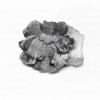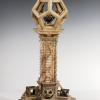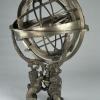Visitors to the Bodleian
Commentary
Image 1. As depicted in Loggan's famous engraving of Selden End, the Bodleian welcomed not only foreign scholars but also gentle visitors. While the one on the right is being conducted on a tour by an academic, the majority of visitors in this engraving -- including a woman and child -- appear to be wandering unaccompanied. What drew them was not only the spectacle of so many books, or the opportunity to gaze at a few precious manuscripts, but also the other objects on display within the library proper and the 'gallery' which occupied what is now the Upper Reading Rooms.
Image 2. A few objects of note can be seen in the companion engraving of Arts End. The entrance is flanked by a pair of standing globes -- one terrestrial, the other celestial -- which became standard furniture of the well-appointed library during the seventeenth century. Bodley himself purchased a pair of extravagantly expensive terrestrial and celestial globes made by Emery Molyneux in 1592, the first globes made in England or by an Englishman. Of interest to both learned and unlearned visitors, this original pair was ruined by overuse: within a decade, Bodley lamented that they were getting so ‘slurred’ (smudged) that their upkeep would become a continuous charge; and Bodleian accounts show payments made to the joiner in 1629, 1636 and in 1644 for mending one or other of the globes. Only six of these globes survive, one of them at Pentworth House. The original pair were discarded in favour of a pair of globes by Willem Blaeu which can be seen in Loggan's engraving of 1675. During these years, globes were also quickly rendered obsolete by expanding geographical knowledge, and the Blaeu globes were apparently also discarded in favour of a more modern pair of smaller globes by John Senex dating from 1728, which reside today in the Rare Books and Manuscript Reading Room of the Weston Library.
The bust of Charles I is depicted in its current location on the right side of the great archway; but the fine portrait bust of Bodley, carved from life in marble and presented in 1605 by the Chancellor, Thomas Sackville, Earl of Dorset, now fixed to the left of the archway, is lacking. The wooden cabinets added at the end of the book-presses contained manuscripts and printed books too rare and precious to be left on open shelves, even when chained.
Other objects. Zacharias Conrad von Uffenbach (1683-1734) visited Oxford as part of his more wide-ranging tour of England. His comments on a visit to the Bodleian Library (19 August 1710) strike a typically supercilious tone, but also reveal something of how several objects now held by Oxford museums were displayed in the early 18th century.
We ran through the three corridors together without moving a single book, and the Sub-Librarian Crab (an arch-ignoramus who, were it not that this was his living, would have preferred sitting in a tavern to being in the Library) merely remarked that there were theological books here. In the lowest corridor, he pointed out where the manuscripts were without reaching down a single one ... At a window, on a table, stood some well-made openwork brass instruments used in geometry, which lay round a five-sided alabaster column, on top of which was a Polyhedron. Near this was also a Globus armillaris of brass on a wooden pedestal. In this pedestal was a drawer, which Mr Crab unlocked, and in which he showed us a very valuable quadrant. This is said to be of pure gold. There are many scales and calculators upon it, but rather badly engraved, though the worthy Crab, to make it seem more costly, opined that the work was even more valuable than the material from which the quadrant was made. I would sooner have had the gold myself. ... This quadrant is more than a Rhenish foot square and possibly six to eight pounds in weight. The artist's name was on it Christophorus Schissler, Geometricus ac Astronomicus artifex Augustae Vindelicorum faciebat 1579. At the present day we know how to make them more conveniently and correctly.
Source. From von Uffenbach's Merckwürdige Reisen, 3 vols (Ulm, 1753-4), III, p. 99-100; for an English translation see W.H. Quarrell and W.J.C. Quarrell, Oxford in 1710: from the Travels of Zacharias Conrad von Uffenbach (Oxford, 1928), pp. 3, 11.
Credits. Howard Hotson, March 2021. The discussion of globes draws on a the Bodleian Map Room Blog.



